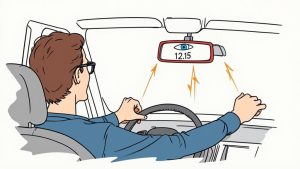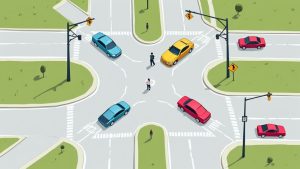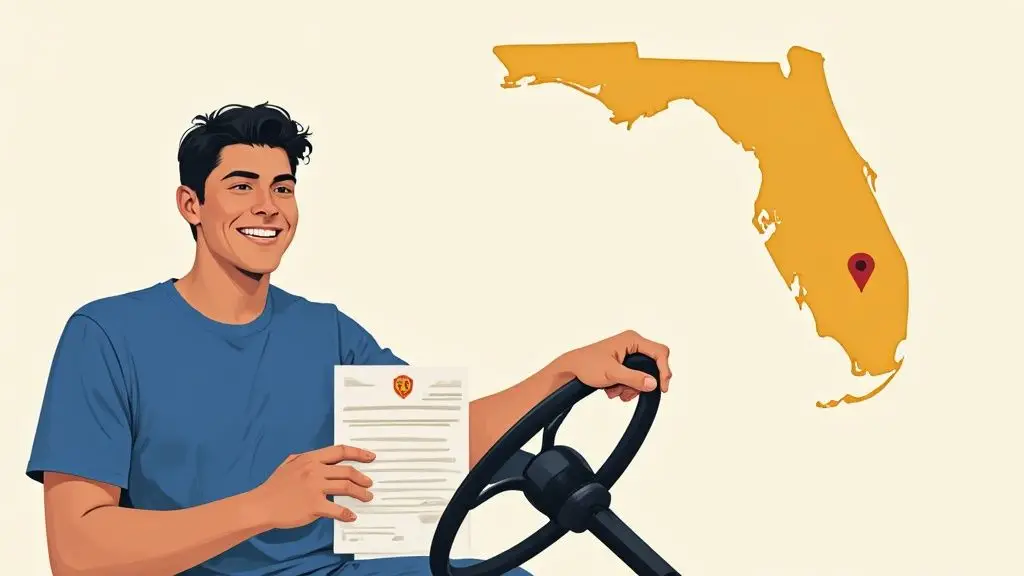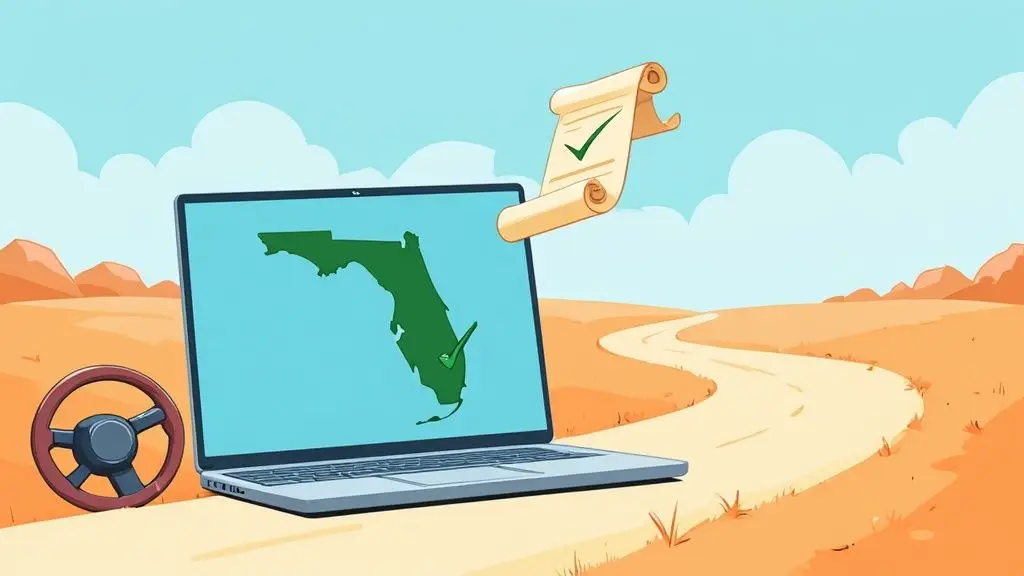Driving in Florida can feel like an adventure, complete with surprise rainstorms and unexpected traffic jams. Learning a few smart tricks, known as defensive driving techniques, is like having a superpower for the road. This isn’t just about driving slowly; it’s about being clever, aware, and ready for whatever the journey throws your way. These expert-level skills help you spot potential trouble before it starts, keeping you and your passengers safe and helping you steer clear of pesky traffic tickets.
Being a safe driver is a big deal under Florida law. For instance, Florida Statute 316.183 emphasizes the need to drive at a “careful and prudent speed,” which can change based on traffic and weather, not just the speed limit sign. You can view the full details of this law on the official Florida Senate website.
Understanding these rules is your first step toward avoiding citations and, more importantly, accidents. A fantastic way to sharpen these abilities is through a Florida approved traffic school, such as a basic driver improvement course (BDI). Taking a florida traffic school online course makes learning these vital skills simple and convenient. Let’s dive into some easy-to-learn techniques that will make a massive difference every time you get behind the wheel.
1. Master the Three-Second Following Rule
Ever feel like the car in front of you is auditioning for a role as a brake pedal tester? In Florida’s busy traffic, sudden stops are as common as sunshine. This is where mastering one of the most fundamental defensive driving techniques becomes your superpower: the three-second following rule. Think of it as an invisible, car-sized safety bubble that you control.
This simple technique, a cornerstone of any basic driver course in Florida, gives you the time and space needed to react to unexpected hazards. Whether it’s a driver slamming on their brakes for a rogue plastic flamingo or a sudden downpour, that three-second cushion is your best defense against a costly and frustrating rear-end collision.
For example, if you’re driving on I-4 near Orlando and the car ahead brakes suddenly, those three seconds give you enough time to slow down safely instead of causing a pile-up.
How to Make it a Habit
Making this rule second nature is surprisingly easy. Just follow these simple steps:
- Pick a Landmark: Choose a fixed object ahead, like an overpass, a specific palm tree, or a road sign.
- Start the Clock: As soon as the rear bumper of the car in front of you passes that landmark, start counting: “One-one-thousand, two-one-thousand, three-one-thousand.”
- Check Your Position: If you pass the same landmark before you finish counting to three, you’re following too closely. Gently ease off the accelerator and let the gap widen.
- Rinse and Repeat: If another driver zips into your newly created space, don’t get frustrated. Just take a breath, back off a bit, and create a new three-second bubble.
This simple count gives you a reliable buffer regardless of your speed. As your speed increases, so does the distance covered in those three seconds, automatically adjusting your safety zone.
For a quick reference on how to apply this rule effectively, the summary below breaks down the key intervals.
As the infographic highlights, extending your following distance to four, five, or even six seconds in bad weather or low visibility isn’t just a suggestion; it’s a critical safety adjustment. Keeping this space is a proactive step that demonstrates responsible driving and helps you avoid needing a basic driver improvement course in the first place.
2. Scan Like a Pilot: Master Situational Awareness
Driving on I-95 can sometimes feel like flying in a combat zone. Cars weave in and out, traffic speeds change in a flash, and you need to have eyes everywhere at once. This is why adopting a pilot’s mindset with proactive scanning and situational awareness isn’t just a pro tip; it’s one of the most powerful defensive driving techniques you can use. Instead of just reacting, you’ll learn to anticipate what other drivers will do before they do it.
This technique, a core principle in advanced police and commercial driver training, involves constantly observing your entire driving environment. By keeping your head on a swivel, you create a 360-degree bubble of awareness, spotting potential hazards from all angles. For example, by scanning far ahead, you might see brake lights two or three cars ahead, giving you extra time to slow down before the car directly in front of you does.
This constant information flow helps you make smarter, safer decisions, turning chaotic traffic into a predictable pattern you can navigate with confidence.
How to Make it a Habit
Developing expert-level situational awareness is a skill that gets stronger with practice. The ‘SIPDE’ method is an excellent framework to start with:
- Search: Actively search the entire scene. Look ahead, check your rearview and side mirrors, and glance at your instrument panel. Your eyes should be in constant motion, never fixed on one spot for more than a couple of seconds.
- Identify: Pinpoint potential hazards. This could be a child chasing a ball, a car lingering in your blind spot, or brake lights flashing three cars ahead.
- Predict: Anticipate the worst-case scenario for each hazard. Predict that the child will run into the street or that the lingering car will suddenly swerve into your lane.
- Decide: Choose your best course of action. This might mean covering your brake, changing lanes to an identified “escape route,” or slowing down to increase your reaction time.
- Execute: Perform the maneuver you’ve decided on smoothly and safely.
By continuously running through this mental checklist, you’ll be prepared for anything Florida’s roads throw at you. This proactive approach is a cornerstone of any good basic driver improvement course and helps keep your driving record clean, avoiding the need to take a course in the first place.
3. Defensive Space Management
Think of your car on a packed Florida highway like a knight in a suit of armor. Just having the armor isn’t enough; you need space to move, react, and swing your sword (or in this case, steer away from trouble). This is the core of Defensive Space Management, a crucial defensive driving technique that turns your car into a fortress with an invisible, protective moat on all sides. It’s not just about what’s in front of you; it’s about creating a safety bubble all around your vehicle.
This strategic positioning is a cornerstone of training for emergency vehicle operators and professional chauffeurs, who understand that having an escape route is non-negotiable.
By actively managing the space ahead, behind, and to your sides, you give yourself precious seconds and multiple options to evade hazards, a skill that every basic driver improvement course aims to instill. For example, by leaving space to your side, you have an “out” if the driver ahead suddenly slams on their brakes. This proactive bubble ensures you aren’t boxed in when another driver makes an unexpected move.
How to Make it a Habit
Building this 360-degree awareness is about actively managing your position in traffic. You can start by implementing these practices:
- Avoid Blind Spots: A car hiding in your blind spot is a collision waiting to happen. The same goes for you lingering in someone else’s. Either speed up slightly or slow down to remain visible in their mirrors.
- Maximize Intersection Visibility: When stopped at an intersection, don’t just hug the bumper in front. Position your vehicle to get the clearest possible view of cross-traffic. This helps you spot potential red-light runners before they become a threat.
- Give Big Rigs Big Space: Large trucks have massive blind spots, or “no-zones.” When passing, do so decisively and avoid driving alongside them for extended periods. The more space you give them, the safer everyone is. Information from the Federal Motor Carrier Safety Administration (FMCSA) helps explain these dangerous areas.
- Adjust for Roadside Hazards: See a line of parked cars, a cyclist, or pedestrians up ahead? Don’t just stay in the middle of your lane. Subtly shift your car to the opposite side of your lane to increase the buffer zone, giving you more time to react if a door swings open or someone steps into the road.
4. Hazard Anticipation and Risk Assessment
Have you ever had that sixth sense that another driver was about to do something unpredictable? That’s not magic; it’s your brain engaging in one of the most powerful defensive driving techniques available: hazard anticipation. This is the art of seeing potential trouble on the road long before it becomes an actual emergency, turning you from a reactive driver into a proactive road ninja.
This mental process, a key component taught in any advanced basic driver course in Florida, involves constantly scanning, identifying, and evaluating potential risks. It’s used by everyone from Formula 1 drivers avoiding high-speed crashes to armored vehicle operators in high-stakes environments. By thinking ahead, you can spot a risky situation—like a car waiting to turn left at an intersection—and adjust your driving before you’re forced to slam on the brakes or swerve dangerously.
How to Make it a Habit
Training your brain to anticipate hazards is like building a new muscle. You can strengthen it by actively looking for potential problems instead of just passively watching the car in front of you.
- Identify High-Risk Zones: Actively recognize when you are entering an area where problems are more likely. This includes school zones, busy intersections, construction areas, and even parking lots where cars and people with support needs are constantly moving.
- Watch for Behavioral Cues: Pay close attention to what other drivers are doing. A car that is repeatedly drifting within its lane, braking erratically, or speeding up to tailgate could be a sign of a distracted or impaired driver. Give them extra space.
- Consider Outside Factors: Your risk assessment should change with the conditions. Driving on a sunny afternoon is different from navigating a torrential downpour at dusk. Adjust your awareness for weather, visibility, and traffic density.
- Play the “What-If” Game: As you drive, mentally rehearse potential scenarios. “What if that car pulls out from the side street without looking?” or “What if that child on the sidewalk chases their ball into the road?” This keeps you mentally prepared to act decisively.
By constantly assessing your surroundings, you can make smarter, safer decisions that keep you out of harm’s way. This forward-thinking approach is a cornerstone of responsible driving and is crucial for maintaining a clean record. For a deeper understanding of road risks, exploring information on Florida traffic safety for all drivers can provide valuable insights.
5. Proper Mirror Usage and Blind Spot Management
Ever had a car appear out of thin air right next to you? Those heart-stopping moments often come from the invisible zones around your vehicle known as blind spots. Effectively managing these areas with your mirrors is one of the most critical defensive driving techniques you can master, turning you from a reactive driver into a truly aware commander of your vehicle.
This skill isn’t just a good idea; it’s a fundamental part of staying safe and avoiding citations on Florida’s unpredictable roads. A systematic approach to checking your mirrors and blind spots keeps you fully aware of the traffic ballet happening around you, preventing sideswipes and dangerous lane-change surprises. For example, before changing lanes on the Palmetto Expressway, a quick shoulder check can reveal a small car that your mirrors missed. It’s a core component of any responsible basic driver course in Florida.
How to Make it a Habit
Transforming this into an automatic process is key to your safety. Integrate these practices into every drive:
- Adjust Before You Drive: Before putting the car in gear, set your side mirrors. Lean your head towards the driver’s side window and adjust the mirror so you can just barely see the side of your car. Repeat on the passenger side. This minimizes the blind spot, showing you the lane next to you, not the side of your own vehicle.
- Implement the “Sweep”: Don’t just glance at one mirror. Develop a continuous, sweeping pattern: check your rearview mirror, then your left side mirror, then your right. This constant scan keeps your mental picture of surrounding traffic up-to-date.
- Always Shoulder Check: Even with perfectly set mirrors and modern blind-spot technology, the quick glance over your shoulder is non-negotiable. This is the only way to be 100% certain the space is clear before you merge, change lanes, or pull away from a curb.
- Practice the Sequence: Make “Mirror-Signal-Mirror-Shoulder Check-Maneuver” your mantra. Say it out loud if you have to. This sequence ensures you communicate your intentions and verify safety before making a single move.
Consistently applying these steps is a hallmark of a skilled, defensive driver. It’s the kind of proactive habit that keeps your driving record clean and helps you avoid the need for a basic driver improvement course. Mastering your surroundings is the ultimate defense.
6. Speed Management and Adjustment
Think that speed limit sign is a suggestion to hit the gas and go? In Florida, treating that number as a target instead of a maximum is a recipe for a close encounter with flashing lights. True defensive driving techniques aren’t just about avoiding tickets; they involve smart speed management and adjustment, turning you from a passive driver into the conductor of your own on-road orchestra.
Strategic speed control is about choosing a speed that fits the current conditions, not just the posted limit. This concept, central to any quality basic driver improvement course, considers everything: traffic flow, rain-slicked I-95 asphalt, or blinding afternoon sun. For example, even if the speed limit is 70 mph, driving that fast in a heavy downpour is reckless. Adjusting your speed proactively gives you the critical seconds needed to react, making the difference between a near-miss and a costly mistake.
How to Make it a Habit
Learning to manage your speed like a pro means thinking beyond the number on the sign. It’s about developing a feel for the road and anticipating what’s ahead.
- Read the Conditions, Not Just the Sign: Posted speed limits are for ideal conditions. Is it raining? Reduce your speed by at least 5-10 mph. Is traffic heavy and unpredictable? Match the flow of the cars around you, as long as it’s safe.
- Extend Your Bubble: In poor weather or low visibility, the three-second rule becomes the four-or-even-five-second rule. This increased buffer automatically forces you to reduce speed to maintain the gap.
- Lead by Example: If traffic is moving dangerously fast, don’t feel pressured to keep up. Maintain a safe, legal speed. Your calm control can have a ripple effect, encouraging others to drive more reasonably.
- Think Like a Pilot: Airline pilots adjust speed based on turbulence; you should adjust based on road hazards. A well-maintained vehicle responds more predictably in these situations. Understanding the link between your car’s condition and its handling is key, which is why topics like these are often covered in driver safety courses. For more information, you can explore details about Florida vehicle maintenance on bdischool.com.
Ultimately, smart speed management is about staying in control. It’s a proactive mindset that reduces wear and tear on your vehicle, saves fuel, and, most importantly, keeps you and others safe on Florida’s dynamic roads.
7. Intersection Safety and Right-of-Way Awareness
Picture a busy Florida intersection during rush hour: cars turning, pedestrians crossing, and cyclists weaving through. It’s a chaotic dance where one wrong move can lead to disaster. This is why mastering intersection safety and knowing right-of-way rules are some of the most critical defensive driving techniques you can practice. These areas are statistical hotspots for collisions, making your awareness and caution paramount.
Understanding and yielding the right-of-way isn’t just polite; it’s a legal requirement designed to keep traffic flowing predictably and safely. As outlined in Florida Statute 316.123, vehicles must stop at stop signs and yield to traffic and pedestrians. Ignoring this can cause serious accidents.
Treating every intersection as a potential hazard zone, rather than a place to rush through, transforms you from a passive participant into a proactive, defensive driver. This mindset is a core lesson in any effective basic driver traffic school Florida course, aimed at preventing citations and crashes.

How to Make it a Habit
Navigating intersections safely requires a consistent, defensive approach. Make these actions part of your routine driving behavior:
- The Complete Stop and Double-Check: At a stop sign, come to a full and complete stop behind the white line. Look left, then right, then left again before proceeding. This “double-take” ensures you catch any vehicle you might have missed on the first glance.
- Green Doesn’t Always Mean Go: A green light gives you permission to proceed, but only when the intersection is clear. Before moving, scan the intersection for red-light runners or pedestrians trying to beat the light.
- Make Eye Contact: Whenever possible, make eye contact with pedestrians and cyclists waiting to cross. This non-verbal communication confirms you see each other and understand one another’s intentions, drastically reducing the risk of a misjudgment.
- Don’t Block the Box: In heavy traffic, avoid entering an intersection unless you are certain you can get all the way across. Blocking an intersection, or “blocking the box,” can cause gridlock and lead to a frustrating traffic citation.
By consistently applying these defensive observation tactics, you help protect yourself and others. Should you have questions about specific scenarios, you can learn more about who has the right-of-way on bdischool.com and become an even safer driver.
8. Weather and Environmental Adaptation
Driving in Florida means being ready for a surprise weather party at any moment. One minute it’s pure sunshine, the next you’re in a torrential downpour that makes it hard to see the car right in front of you. This is where adapting your driving to the environment isn’t just a good idea; it’s one of the most critical defensive driving techniques you can master. It’s about recognizing that your car handles differently when the road is wet, foggy, or covered in debris after a storm.
This skill, often highlighted in any basic driver traffic school Florida program, involves actively adjusting your speed, following distance, and overall approach to match the conditions. By becoming a more adaptable driver, you significantly lower your risk of hydroplaning, skidding, or being involved in a collision caused by reduced visibility or slick roads. For example, when hydroplaning, you should ease off the gas and steer straight until you regain control—never slam the brakes. It’s about respecting Mother Nature and giving your vehicle the best chance to maintain traction and control.
How to Make it a Habit
Turning into an all-weather pro is about building a new set of automatic responses. Start by integrating these practices into your driving routine:
- Slash Your Speed: Your tires need more time to grip a wet or slick surface. As a rule, reduce your speed by at least 25% in heavy rain. If conditions are extremely poor, slowing down by 50% is a safe bet.
- Lights On for Safety: In rain, fog, or at dawn and dusk, turn on your headlights. Florida law requires it when your windshield wipers are in use. This isn’t just so you can see; it’s so other drivers can see you.
- Smooth and Steady Wins the Race: On slippery surfaces, sudden movements are your enemy. Avoid slamming on the brakes, jerking the steering wheel, or punching the accelerator. All inputs should be gentle and deliberate to prevent loss of traction.
- Double Your Following Distance: The three-second rule is a great starting point for sunny days. In bad weather, extend that to at least four to six seconds to give yourself ample time to react and stop safely.
These adjustments are a cornerstone of responsible driving and can help keep your record clean. Learning how to handle these situations is a key part of any driver safety course. For a deeper dive into staying safe when the skies open up, you can get more information on driving safety during severe weather in Florida on bdischool.com.
Defensive Driving Techniques Comparison Table
| Technique | Implementation Complexity  | Resource Requirements  | Expected Outcomes  | Ideal Use Cases  | Key Advantages  |
|---|---|---|---|---|---|
| Three-Second Following Rule | Low – simple counting method | Minimal – no special equipment | Significant reduction (~50%) in rear-end collisions | General driving in normal and varied conditions | Easy to learn and apply consistently |
| Scanning and Situational Awareness | Moderate – requires continuous mental focus | Moderate – mental effort, practice needed | Early hazard detection; reduces blind spot incidents by 35-40% | Highway and urban driving; complex traffic scenarios | Improves decision-making time and confidence |
| Defensive Space Management | Moderate to High – constant adjustment | Moderate – attentive driving and positioning | Multiple escape routes; reduced collision severity | Emergency response, professional driving, heavy traffic | Enhances safety through space cushion |
| Hazard Anticipation and Risk Assessment | High – requires experience and knowledge | High – mentally intense and requires training | Prevents accidents proactively; improves judgment | Advanced driving, professional, and high-risk environments | Develops superior driving judgment |
| Proper Mirror Usage and Blind Spot Management | Low to Moderate – habit formation required | Minimal – relies on proper mirror adjustment | Dramatic reduction in lane-change accidents | All driving environments; essential for merging and backing | Essential for blind spot awareness |
| Speed Management and Adjustment | Moderate – requires good judgment | Minimal – practice and situational awareness | Reduces accident severity; improves fuel efficiency | Variable conditions, adverse weather, traffic flow | Matches safe speed to driving conditions |
| Intersection Safety and Right-of-Way Awareness | Moderate – requires rule knowledge and focus | Minimal – cognitive focus | Prevents up to 40% of intersection-related accidents | Urban/suburban driving; intersections and crosswalks | Protects vulnerable road users effectively |
| Weather and Environmental Adaptation | High – extensive practice needed | Moderate to High – equipment and skill | Dramatically lowers weather-related accidents | Driving in rain, snow, fog, ice, or extreme weather | Builds confidence and safety in adverse conditions |
Turn Your Knowledge into Confidence with a BDI Course
You’ve just journeyed through the essential playbook for conquering Florida’s roadways. From maintaining the life-saving three-second cushion and mastering the art of constant scanning, to creating a protective bubble of space around your vehicle, these aren’t just abstract ideas. These are concrete, actionable defensive driving techniques that can turn a potentially chaotic commute into a controlled, predictable drive. We’ve explored how to anticipate hazards like a chess master, manage your speed like a professional driver, and navigate intersections with the confidence of a traffic controller.
Think of these skills as your new superpower. By putting them into practice, you’re not just avoiding a traffic citation; you’re actively taking control of your safety and the safety of everyone around you. You are transforming from a passive operator into a proactive guardian of the road. The true value lies in making these techniques second nature, so they become as automatic as checking your mirrors before you change lanes. This is how you build a permanent shield against the unexpected.
From Theory to Practice: Solidify Your Skills
Reading about these methods is the first crucial step, but the best way to truly cement this knowledge and reap the benefits, such as avoiding points on your license or lowering your insurance rates, is through a structured, state-approved program. This is where a Basic Driver Improvement (BDI) course becomes your greatest ally. It takes these principles and organizes them into a simple, easy-to-digest format that reinforces everything you’ve learned.
Our Florida online traffic school is the premier tool to solve your driver education needs in a fast and easy way. Whether you need to satisfy a court order for a recent ticket or you’re just wisely investing in your driving education, we provide a fully online solution. Our courses are DHSMV-approved and cater to all needs:
- 4-Hour Basic Driver Improvement (BDI): The perfect basic driver traffic school Florida course for most common traffic tickets. Completing it helps you avoid points on your license and can prevent insurance increases.
- 8-Hour Intermediate Driver Improvement (IDI): Often required by a judge for more serious violations. This course provides a deeper dive into defensive driving.
- 12-Hour Advanced Driver Improvement (ADI): A mandatory course for drivers needing to reinstate their license after certain suspensions or revocations.
- First Time Driver / DETS / TLSAE: A required driver education traffic safety & drug and alcohol course for anyone getting their first Florida driver’s license. It’s the foundation for a lifetime of safe driving.
Our Florida approved traffic school platform is designed to be straightforward and accessible. You can complete the course at your own pace and get your certificate instantly upon completion. Don’t let your knowledge fade. Turn it into real-world confidence and a cleaner driving record today.
Ready to master these defensive driving techniques and enjoy the benefits of being a safer, more skilled driver? Enroll in a course with BDISchool and take the first step towards a better driving future. Visit our courses page to find the perfect option for you and register in minutes.





